|
 Humidicutis luteovirens Humidicutis luteovirens
SynonymsHygrocybe luteovirens
BiostatusPresent in region - Indigenous. Endemic
Images (click to enlarge)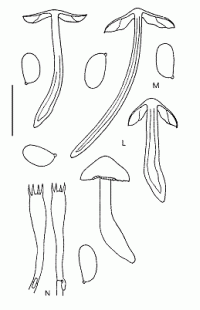
Caption: Fig. 47 Humidicutis luteovirens (Horak) Horak (L-N: ZT 2007):
L. basidiomes (ZT 2007, above; ZT 2081, below) M. spores. N. basidia | 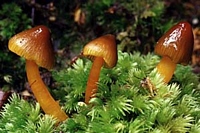
Caption: Humidicutis luteovirens
Owner: Kaimai Bush | 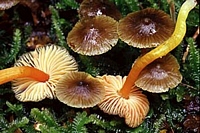
Caption: Humidicutis luteovirens
Owner: Kaimai Bush | 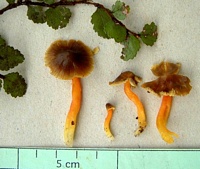
Owner: Karl Soop | 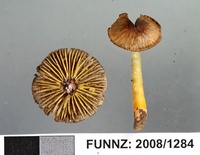
Owner: J.A. Cooper | 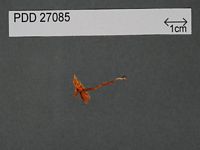
Caption: Dried type specimen
Owner: Herb PDD | 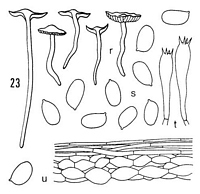
Caption: Hygrocybe luteovirens Hk. (type): r. carpophores. - s. spores. - t. basidia. - u. cuticle | 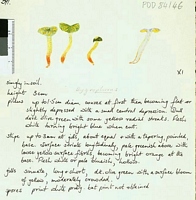
Caption: Watercolour
Owner: G.M. Taylor | |
Article: Horak, E. (1973). Fungi Agaricini Novazelandiae I-V. Beihefte zur Nova Hedwigia 43: 200 p.
Description: Pileus 10-20 mm diam., convex becoming umbonate to campanulate, margin upturned in aged carpophores, deep green at the centre, yellow towards the estriate margin, reddish-brown drying out, not hygrophanous, dry. Lamellae decurrent, lemon yellow to greenish-yellow, moderately distant, gill edge concolorous. Stipe 20-35 x 1-2 mm, cylindric or attenuated towards the base, yellowish above, deeper coloured at the base, finally becoming pinkish, glabrous, dry, hollow, single or fasciculate. Context greenish in the pileus. Odor and taste not distinctive. Chemical reaction on pileus: KOH, HCl and NH3 - green colours of the pileus fading immediately.
Spores 6-8 x 4-4.5 µm, ellipsoid, smooth, inamyloid. Basidia 35-42 x 7µ, 4-spored. Cystidia absent. Cuticle a cutis of repent, cylindric hyphae (3-6 µm diam.), membrane not gelatinized, subcutis-subcellular. Clamp connections absent.
Habitat: In soil under Weinmannia, Schefflera, Aristotelia, Fuchsia, etc. New. Zealand.
Notes: This species has the colours of Gl. psittacinus (Fr.) but its spores are considerably smaller and neither pileus nor stipe are glutinous. A species closely related to H. luteovirens is reported from Japan. However, H. olivaceo-viridis Hongo (1967) differs from the N.Z. species by its emarginate-adnate lamellae, its more conic pileus, its habitat, and microscopical characters of the hyphae composing the cuticle.
Article: Horak, E. (1990). Monograph of the New Zealand Hygrophoraceae (Agaricales). New Zealand Journal of Botany 28(3): 255-306 (http://www.rsnz.org/publish/abstracts.php).
Description: Pileus -30 mm, conico-convex becoming umbonate to campanulate, margin often
upturned and centre depressed in aged specimens; green gradually changing to
yellow, yellow-brown, brown or reddish brown with age; dry or lubricous, glabrous
to minutely fibrillose or silky, sometimes splitting at striate margin, hygrophanous.
- Lamellae 10-18 (1 -5) emarginate to adnate finally decurrent, ventricose,
up to 5 mm wide; lemon yellow, ochre or greenish yellow, edges entire, concolorous
or conspicuously golden yellow or ochre. - Stipe 20-60 x 1-4 mm, cylindrical,
equal, subfusoid or attenuated towards base; green to yellowish at apex, pinkish
orange at upper portion (occasionally with pale blue tinge), orange-pink to
pale brown at base; dry, glabrous, hollow, brittle, single or caespitose. -
Context pale green in pileus, orange with blue tinge at apex of stipe, orange-pink
in base of stipe. –Odour and taste not distinctive. - Chemical reactions on
pileus: KOH, HCI, and NH3 - green, coloration soon fading away.
Spores 6-8 x 3.5-4.5 um, ellipsoid. - Basidia 25-42 x 6-7 um, 4-spored, with
medallion-like clamp connection at basal septum. - Cystidia absent - Pileipellis
a cutis of repent, cylindrical hyphae (25 ,um diam.), membranes not gelatinised,
encrusted with pigment; clamp connections absent on septa of subcuticular hyphae
(Pl. 1, Fig. 8).
Habitat: ECOLOGY: Common; saprobic on soil among litter under Nothofagus (N. truncata,
N. menziesii), Leptospermum scoparium, Podocarpus-Dacrydium or in mixed
forests. December-March.
Distribution: DISTRIBUTION: NZ (N, WL).
Notes: Originally this fragile and delicately coloured species was considered to belong
to Hygrocybe (Horak 1973: 148). The re-examination of the type material
revealed, however, that clamp connections are generally absent at the septa
of the hyphae but present at the base of the basidia. As a consequence the transfer
of H. luteovirens to Humidicutis is proposed.
To date, only two representatives of Humidicutis with distinctive green
coloured basidiomes are reported from New Zealand viz. H. luteovirens
(Horak) and H. multicolor (Berk. & Br.) Horak. In the field the latter
taxon, at first sight, can be readily taken for H. luteovirens (Horak)
which, however, lacks the conspicuous blue colour in the cortex of pileus and
stipe.
|